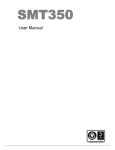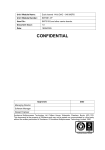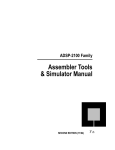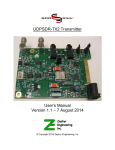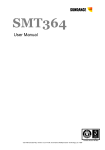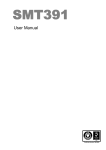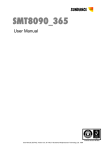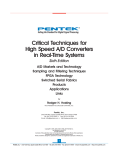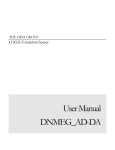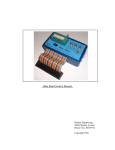Download SMT390 - User Manual
Transcript
SMT390-VP User Manual Version 2.4 Page 2 of 55 SMT390-VP User Manual Revision History Date Comments Engineer 05/02/04 Preliminary version. PSR 0.9 19/02/04 Trigger characteristics added – SHB Location corrected. PSR 1.0 18/03/04 Details about clock synthesizer configuration. Dimensions added. MTBF Added PSR 1.1 29/03/04 Details on SMT338VP to PSR 1.2 01/04/04 Update temperature registers number PSR 1.3 19/05/04 Update Configuration sequence and power connector pinout (JTAG lines were missing) PSR 1.4 25/05/04 Changed title to SMT390-VP JPA 1.5 JPA 1.6 how to connect and SMT390 serial Version Update Register Description section: - Trigger Register - Decimation Register - ADC over range register SHB and ComPort sections updated 15/06/04 Removed MemoryBypass Mode. Updated registers section. RSL are not available. Updated ADC Setup Control Register. Added Firmware description section. Added Setting-up an acquisition section. Added Configuring the FPGA section. 28/06/04 Review and minor changes added PSR 1.7 14/07/04 ADC and External clock schematics added – Module temperatures added – FPGA usage added PSR 1.8 24/03/05 Due to complete recoding of the microcontroller code the serial number feature has been removed. Also correction of the interface between the microcontroller and the FPGA. E.P 1.9 Version 2.4 07/06/05 Page 3 of 55 Added: power consumptions SMT390-VP User Manual SM 2.0 Corrected: SDRAM storage capacity 63.75MB Corrected: Figure 30 – SHB control register 22/09/06 Information about cooling added PSR 2.1 12/11/06 Input speficied in dBms PSR 2.2 06/12/06 Clock synthesizer corrected PSR 2.3 25/05/07 Reference oscillator details added PSR 2.4 Version 2.4 Page 4 of 55 SMT390-VP User Manual Table of Contents Revision History............................................................................................................ 2 Table of Contents ......................................................................................................... 4 Table of Figures............................................................................................................ 6 Precautions (Please Read this!)................................................................................... 7 Physical Properties ....................................................................................................... 8 Dimensions ............................................................................................................... 8 Introduction ................................................................................................................. 10 Introduction ................................................................................................................. 10 Overview ................................................................................................................. 10 Module features ...................................................................................................... 10 Power consumption ................................................................................................ 10 Possible applications .............................................................................................. 11 Related Documents ................................................................................................ 11 Functional Description ................................................................................................ 11 Block Diagram......................................................................................................... 11 Module Description ................................................................................................. 12 Communication Ports (ComPorts). ......................................................................... 13 Sundance High-speed Bus - SHB. ......................................................................... 13 Inputs and outputs main characteristics ................................................................. 14 Data Stream Description......................................................................................... 16 Block diagram...................................................................................................... 16 Description of Internal FPGA Blocks................................................................... 17 Clock Structure........................................................................................................ 18 Power Supply and Reset Structure......................................................................... 19 MSP430 Functionality ............................................................................................. 20 Analog input section................................................................................................ 22 ADC Settings........................................................................................................... 22 Description of Interfaces............................................................................................. 22 Memory Interface .................................................................................................... 22 MSP430 Interface ................................................................................................... 22 Serial Number ......................................................................................................... 22 Version 2.4 Page 5 of 55 SMT390-VP User Manual Green LEDs ............................................................................................................ 23 ADC Data Interface................................................................................................. 23 Clock synthesizer Interface..................................................................................... 23 Clock Routing.......................................................................................................... 23 TIM Interface ........................................................................................................... 23 RSL Interface (RSL are not available) .................................................................... 23 RSL Connector and Pinout Definition ................................................................. 23 RSL Cable Definition ........................................................................................... 27 SHB ......................................................................................................................... 27 Daughter-card Interface .......................................................................................... 30 Firmware description .................................................................................................. 37 SHB full word configuration..................................................................................... 38 SHB half word configuration ................................................................................... 38 Setting-up an acquisition ............................................................................................ 38 Configuring the FPGA ................................................................................................ 39 Control Register Settings............................................................................................ 40 Control Packet Structure......................................................................................... 40 Reading and Writing Registers ............................................................................... 40 Memory Map ........................................................................................................... 41 Register Descriptions.............................................................................................. 42 Global FPGA Reset Register (0x00) ................................................................... 42 Clock Synthesizer Control Register (0x02) ......................................................... 42 Clock Routing Selection Register (0x03) ............................................................ 42 Acquisition trigger register (0x06) ....................................................................... 43 ADC Setup Control Register (0x07) .................................................................... 44 Decimation Register (0x08)................................................................................. 44 SHB Control Register (0x09)............................................................................... 44 Main Module Temperature Register (0x0A)........................................................ 45 Main Module FPGA Temperature Register (0x0B) not available........................ 45 Daughter Module Temperature Register (0x0C) not available ........................... 45 Daughter Module ADC Temperature Register (0x0D) not available .................. 45 Main Module Silicon Serial Number Words0, 1, 2 and 4 (0x10, 11, 12 and 13). 45 Daughter Module Silicon Serial Number Words0, 1, 2 and 4 (0x14, 15, 16 and 17). not available ................................................................................................. 45 Version 2.4 Page 6 of 55 SMT390-VP User Manual Firmware Version Registers (0x1A) .................................................................... 45 PCB Layout................................................................................................................. 46 Connector Location .................................................................................................... 49 JTAG Cable pinouts ................................................................................................... 50 Virtex II PRO FPGA. ............................................................................................... 50 TI MSP430 Microcontroller ..................................................................................... 51 How to interconnect SMT390 and SMT338-VP on a carrier board?.......................... 52 Appendix..................................................................................................................... 55 Table of Figures. Figure 1 - Side View Module. ....................................................................................... 9 Figure 2 - General block diagram............................................................................... 12 Figure 3 - Main features. ............................................................................................ 14 Figure 4 - ADC input stage. ........................................................................................ 15 Figure 5 - External Clock Input Stage. ....................................................................... 15 Figure 6 – Internal FPGA Architecture. ...................................................................... 16 Figure 7 - Clock Structure........................................................................................... 18 Figure 8 – Power Generation and Distribution ........................................................... 20 Figure 9 - Microcontroller State Machine. .................................................................. 21 Figure 10 – Rocket Serial Link Interface. ................................................................... 24 Figure 11 – Rocket Serial Link Interface Connector and Pinout (RSL A) .................. 25 Figure 12 – Rocket Serial Link Interface Connector and Pinout (RSL B) .................. 26 Figure 13 – Samtec HFEM Series Data Cable. ......................................................... 27 Figure 14 –SHB Connector Configuration 2 Pinout. .................................................. 29 Figure 15 – Daughter Card Connector Interface........................................................ 30 Figure 16 – Daughter Card Interface Power Connector and Pinout .......................... 32 Figure 17 – Daughter Card Interface: Data Signals and Pinout (Bank A). ............... 33 Figure 18 – Daughter Card Interface: Data Signals and Pinout (Bank B). ................ 35 Figure 19 – Daughter Card Interface: Data Signals and Pinout (Bank C). ................ 36 Figure 20: SMT390-VP state diagram........................................................................ 37 Figure 21: SMT390-VP channels output .................................................................... 38 Figure 22 – Setup Packet Structure. .......................................................................... 40 Version 2.4 Page 7 of 55 SMT390-VP User Manual Figure 23 – Control Register Read Sequence. .......................................................... 40 Figure 24 – Register Memory Map............................................................................. 41 Figure 25 – Clock Synthesizer Control Register (0x02). ............................................ 42 Figure 26 – Clock Routing Register (0x03). ............................................................... 42 Figure 27 - Acquisition trigger register (0x06). ........................................................... 43 Figure 28 – ADC Setup Control Register (0x07)........................................................ 44 Figure 29 – Decimation Register (0x08)..................................................................... 44 Figure 30 – SHB control Register (0x08). .................................................................. 45 Figure 31 – Module Top View (Main Module). ........................................................... 46 Figure 32 – Module Bottom View (Main Module). ...................................................... 47 Figure 33 – Top View (Daughter-card)....................................................................... 47 Figure 34 - Bottom View (Daughter-card). ................................................................. 48 Figure 35 - Connector Location.................................................................................. 49 Figure 36 - Pinout FPGA JTAG cable. ....................................................................... 50 Figure 37 - Pinout MSP430 JTAG cable. ................................................................... 51 Figure 38 - SMT390 to SMT338-VP Interconnections. .............................................. 52 Figure 39 – Fixings ..................................................................................................... 52 Precautions (Please Read this!). In order to guarantee that the SMT390-VP functions correctly and to protect the module from damage, the following precautions should be taken: - The SMT390-VP is a static sensitive product and should be handled accordingly. Always place the module in a static protective bag during storage and transition. - At all time, make sure that the heat generated by the system is extracted e.g. by the use of a fan extractor or an air blower. Sundance recommends to use a fan (as a reference : PAPST 8300 series - 12-Volts – 31.8 CFM) to blow across the PCI bus when the board is used within a PCI system. This is vital not to damage any of components. - SHB and RSL connectors are similar but their use is really different. Do NOT connect an SHB and an RSL connectors together with and SHB cable! This would cause irreversible damages to the modules. Version 2.4 Page 8 of 55 SMT390-VP User Manual Physical Properties Width: 63.5mm. Dimensions Length: 106.68mm. Height: 21mm maximum. Weight 104 Grams (including fan and fixings) Supply Voltages 3.3V and 5V Supply Voltages available on Daughter 1.5V, 2.5V, 3.3V, 5V, +12V and –12V Module +12V Supply Current +5V +3.3V -5V -12V 31398.75 hours MTBF Temperatures (measured in a 23degree environment) FPGA – SMT338-VP 67°C max ADCs – back SMT390 52°C max SMT390 board 45°C max SMT338-VP board 61°C max FPGA Usage RAMB16 8 out of 136 (5%) Slices 3909 out of 13696 (28%) Bufgmux 9 out of 16 (56%) DCMs 4 out of 8 (50%) Version 2.4 Page 9 of 55 SMT390-VP User Manual SMT390-VP RF Daughtercard PCB Inter PCB Connector Only required for debugging Fan 7.6mm ADC - 1.6MM JTAG 6.4 mm 21.0 mm SHB 1.2 mm RSL FPGA T Power Stand-off Module PCB Figure 1 - Side View Module. TIM Connectors T Version 2.4 Page 10 of 55 SMT390-VP User Manual Introduction Overview The SMT390-VP is a single width TIM, which converts 2 analogue signals into two 12-bit resolution digital data flows. Analogue to digital conversion is performed by two Analog Devices AD9430s - they are 3.3-Volt 12-bit data CMOS devices that can sample at up to 210 MSPS. Digital data travel to a Xilinx Virtex-II Pro FPGA (XC2VP30-6 - FF896 package), controlled via ComPorts words. Samples are first stored into the on-board memory and then transferred onto the Sundance High-speed Bus (SHB), common to a wide range of Sundance products. A copy of the data will also be streamed over the RocketIO Serial Links on the module (RSL) in a future version. These interfaces are compatible with a wide range of Sundance processor and I/O modules. The FPGA is configured at power-up via Comport 3. The configuration process is controlled by a microprocessor MSP430. Once the FPGA is configured, the configuration ComPort becomes a control ComPort to set FPGA internal registers. Module features The main features of the SMT390-VP are listed below: ● Dual-ADC board, ● On-board low-jitter clock generation, ● 210 Mega Samples Per Second and per channel, ● 12-bit resolution, ● Two external clocks and two external triggers via MMCX (or MMBX – to be specified on order) connectors, ● Two 64-MByte banks of DDR SDRAM for sample storage. Banks are organised in 32-bit words. ● Two Standard Sundance ComPorts, ● Two SHB interfaces for easy interconnection to Sundance products, ● Two RSL (Rocket-IO Serial Link) interfaces for fast output transfers, ● All inputs are 50-Ohm terminated, ● On-board MSP430 microprocessor. Power consumption The SMT390-VP (SMT338-VP+SMT390) consumes about 9.57Watts (with data acquisition running), and about 7.86Watts in idle state but after configuration of the 338VP). Version 2.4 Page 11 of 55 SMT390-VP User Manual Possible applications The SMT390-VP can be used for the following application (this non-exhaustive list should be taken as an example): ● Broadband cable modem head-end systems, ● 3G radio transceivers, ● High-data-rate point-to-point radios, ● Medical imaging systems, ● Spectrum analyzers Related Documents AD9430 Datasheet - Analog Devices Sundance High-speed Bus (SHB) specifications – Sundance Sundance LVDS Bus (SLB) Specifications – Sundance TIM specifications Xilinx Virtex-II PRO FPGA MMCX Connectors – Hubert Suhner: MMCX Connectors Surface Mount MMCX connector MMBX Connectors – Hubert Suhner: MMBX Connectors Surface Mount MMBX connector Sundance’s firmware general description - SMT6400 Functional Description In this part, we will see the general block diagram and some comments on each of its entities. Block Diagram The following picture shows the block diagram of the SMT390-VP. LVPECL Trigger Distribution 2 Ext Trigger Inputs (MMCX) Notes: Channel B Signal Conditioning Channel B Input MMCX Connector Vin B (1d) Vin A (1d) Debug IOs and LEDs ADC - AD9430 12-bit 210MSPS ADC - AD9430 12-bit 210MSPS Clock (2d) The numbers in brackets denote the amount of FPGA IO pins requires. 'd' is used for differential pairs. 1d Will thus requre 2 IOs Power Channel A Signal Conditioning LVPECL Clock Generation and Distribution Channel A Input MMCX Connector 2 Ext. Clock Inputs (MMCX) Low Jitter Local Oscillator Data (21) Control (4) Trigger (2d) 512MBit for Channel B ChB Data, Clock and Control (14d) ChA Data, Clock and Control (14d) Clock (1d) Control (4) Control (6) 512MBit for Channel A 256MBit DDR SDRAM 256MBit DDR SDRAM Data, Clock and Control (93) 256MBit DDR SDRAM 508 / 556 IOs FF896 Package Virtex-II Pro XC2VP20-6 or 30-6 Data, Clock and Control (93) 256MBit DDR SDRAM ChB Data, Clock and Control (60) DataTx (4d) DataRx (4d) ComPorts and Control (59) DataTx (4d) DataRx (4d) ChA Data, Clock and Control (60) SHB for Channel B 4 RocketIO Links for Channel A (1GByte/s effective Data throughput) Top and Bottom TIM Connectors 4 RocketIO Links for Channel A (1GByte/s effective Data throughput) SHB for Channel A Version 2.4 Page 12 of 55 SMT390-VP User Manual Figure 2 - General block diagram. Module Description The module is built around a Xilinx Virtex-II Pro FPGA and two Analog Devices AD9430 12-bit monolithic analog-to-digital converters. Version 2.4 Page 13 of 55 SMT390-VP User Manual Analog data enters the module via two MMCX connectors, one for each channel. Both signals are then conditioned (AC coupling) before being digitized. Both ADCs gets their own sampling clock, which can be either on-board generated or from an external source (MMCX connector). ADCs can receive either their own external clock or both the same external clock or both the same on-board clock, or even opposite external clocks. Two more MMCX connectors are dedicated for two external trigger signals. External clocks and triggers can be either single-ended or differential (the selection is made on hardware), whereas the analogue input is single-ended only. ADCs digital outputs are fed into the FPGA. They can be passed directly on both SHB connectors or stored into the on-board DDR SDRAM memory to be transferred afterwards via SHB connectors. ADCs data stream can also be transmitted via RSL connectors (RSL will be available on a future version of the FPGA firmware). The design of the SMT390-VP is split over two PCBs. The main PCB (main module – SMT338-VP) contains the FPGA, the memory, the microcontroller and the digital connector interfaces (TIM, SHB and RSL). The second PCB (daughter card – SMT390) contains all the analogue circuitry as well as the clock generation, trigger control, analogue signal conditioning and ADCs. The FPGA gets control words from a ComPort interface following the Texas Instrument C4x standard. It then feeds both ADCs with a differential encode signal, from one of the following sources: external (via MMCX connector) or internal (onboard clock generator). Two parallel LVDS buses carry 12-bit samples (2’s complement or offset binary format - SLB) from both converters to the FPGA, which sends them out through both SHB connectors. Note that samples coming from ADC Channel A are output on SHBB (J8) and that samples coming from ADC Channel B are output on SHBA (J7). Two full (60-pin) SHB connectors are accessible from the FPGA. They are output only to send out digital samples to another module. Please refer to the SHB specifications for more details about ways connectors can be configured. A global reset signal is mapped to the FPGA from the bottom TIM connector via the MSP430 microcontroller. Communication Ports (ComPorts). The SMT390-VP provides 2 ComPorts: 0 and 3. ComPort 3 is used to configure and send control words the FPGA. The SMT6400 help file provides more information about ComPorts. The ComPorts drive at 3.3v signal levels. Sundance High-speed Bus - SHB. 2 SHB connectors are used to transmit data coming from ADCs to external world. Both SHB buses are identical and 60-bit wide. See SHB technical specification for more information. Version 2.4 Page 14 of 55 SMT390-VP User Manual Inputs and outputs main characteristics The main characteristics of the SMT390 are gathered into the following table. Analogue inputs 11dBms – Full scale (twice for Half Scale) AC coupled. Input voltage range (Scale selection via control register) Impedance 50Ω - terminated to ground – single ended ADC bandwidth: 700 MHz. Bandwidth Input RF transformer: 800MHz. External sampling clock inputs Single ended or differential (3.3V PECL) – AC coupled. Format 40-210 MHz Frequency range External Trigger inputs Single ended or differential (3.3 V PECL) – DC coupled. Format 1.4 Volts peak-to-peak minimum Input Voltage range 105 MHz maximum Frequency range SMT390 Output Output Data Width 12-Bits 2’s Compliment or offset binary Data Format (Changeable via control register) SFDR Up to 68dB (80dB is the maximum provided by Analogue Devices) SNR Up to 56dB (65dB is the maximum provided by Analogue Devices) Maximum Sampling Frequency 210 MHz. SMT390 On-board reference crystal (used by clock synthesizer) 16MHz Frequency Frequency stability over temperature Part number +/-50ppm typical Raltron AS-SMD series (AS-16.000-18-SMD) Figure 3 - Main features. Version 2.4 Page 15 of 55 SMT390-VP User Manual The following pieces of schematic show the Analogue and External clock input stages: Figure 4 - ADC input stage. Figure 5 - External Clock Input Stage. Version 2.4 Page 16 of 55 SMT390-VP User Manual Data Stream Description Block diagram The data-path for both channels (ADCs) on the module and in the FPGA is identical. The ADCs are driven by its own clock either generated on the module or provided by the user through an MMCX connector. The following diagram shows the data-path inside the FPGA. DDR SDRAM Memory Interface Pre-process Data ADC A Channel A ADC B Channel B Store in Memory Retrieve from Memory SHB Interface SHB for Channel B Pre-process Data SI RSL for Channel A Pre-process Data SI RSL for Channel B SHB Interface SHB for Channel A Duplicate Data Duplicate Data Pre-process Data Store in Memory Retrieve from Memory Memory Interface DDR SDRAM Figure 6 – Internal FPGA Architecture. The analog data are converted by the ADC converters. A single 12-bit parallel LVDS data-stream is generated by each ADC (i.e. for each channel). This data-stream is duplicated in the FPGA. One stream is transmitted as is over the RSL interface for real-time type applications (RSL will be available on a future version of the FPGA firmware). The second data-stream is stored in DDR SDRAM every time a trigger is received. This data is kept in the memory until a non-real-time type module collects the data over the SHB interface. Note that samples coming from ADC Channel A are output on SHBB (J8) and that samples coming from ADC Channel B are output on SHBA (J7). Version 2.4 Page 17 of 55 SMT390-VP User Manual Description of Internal FPGA Blocks Duplicate Data This block takes the incoming data stream and makes two copies of it. The first copy is used for real-time type applications where the full conversion data-stream is transmitted off the module. This option is not available yet. The second stream is for non-real-time type applications where samples are captured and stored in memory. Pre-processing Data The data pre-processing block performs basic operations on the data-stream (Decimation). SI The Serial Interface block takes the parallel input data stream and converts it into a high-speed serial data stream. This data stream is 16b encoded. On the receiving side the clock is recovered out of the serial data stream and the 16b data is decoded to 12b. Store in Memory The store in memory block takes the incoming data stream and stores the data into DDR SDRAM. This block will only transfer data into the memory when a valid trigger command is received. The amount of data that must be stored is configurable. Memory Interface The memory interface block is the DDR SDRAM controller. This block is responsible to all write and read transactions to and from the DDR SDRAM. Each 12-bit sample is stored into a 16-bit memory location or two samples packed into a 32-bit word. Retrieve from Memory The retrieve from memory block retrieves stored data in the DDR SDRAM when it receives a valid read command. The read command specifies the location and amount of data that needs to be retrieved. Version 2.4 Page 18 of 55 SMT390-VP User Manual SHB Interface The retrieved data from the ‘Retrieve from Memory’ block is transmitted over the SHB interface. The SHB interface controls the SHB bus between the SMT390-VP and any module connected to the SHB requesting the data. Clock Structure There is an integrated clock generator on the module. The user can either use this clock or provide the module with an external clock (input via MMCX connector). The RSL interface will only function if the module’s integrated clock is used (RSL are not available). External Clocks Module Clock External Clock Inputs (MMCX) Clock synthsizer LVPECL Buffers TTL to LVPECL 4:2 Mux with Dual Output ADCB Ch B Clock Ch A Clock ADCA LVDS SerDes Clock RSL Clock DLL Sys Clock DLL FPGA Diagram Key: 210 MHz LVPECL Clock Figure 7 - Clock Structure. Clock Control Version 2.4 Page 19 of 55 SMT390-VP User Manual Each ADC can receive as encode signals, the on-board clock or its own external clock or the other channel’s clock. It also means that an external clock can encode both ADCs. Power Supply and Reset Structure The SMT390-VP conforms to the TIM standard for single width modules. The TIM connectors supply the module with 5.0V. The module also requires an additional 3.3V power supply, which must be provided by the two diagonally opposite mounting holes. This 3.3V is present on all Sundance TIM carrier boards. From the 5.0V the FPGA Core Voltage (VCCINT = 1.5V), the FPGA Auxiliary voltage (VCCAUX = 2.5V) is generated. The FPGA IO Voltage (VCCO = 3.3V) is taken straight from the TIM mounting holes. The 3.3V, 5.0V, +12V and –12V present on the TIM connector are passed up to the daughter card, as well as a 1.5V and a 2.5V. The daughter card is responsible for generating its required voltages. A TI MSP430 low power microprocessor is located on the main module. This microprocessor controls the power sequencing for the main module. High efficiency Vishay DC/DC converters are used to generated the lower voltages. On the daughter card the Analog Devices ADCs require analog and digital 3.3V. The 3.3V from the main module to daughter card power connector is used for the digital 3.3V. This voltage is taken from the 5-Volt rail and filtered to provide the analog 3.3V. The MSP430 microprocessor also controls the reset sequence for the SMT390-VP. There are two possible reset sources for the SMT390-VP: 1. A reset is received over the TIM connector 2. After power up an internal Power On Reset in the MSP430 causes a reset Version 2.4 Page 20 of 55 SMT390-VP User Manual The MSP430 distributes the reset to the daughter board. The following diagram illustrates the power distribution and the reset distribution on the SMT390-VP: TIM Connector D+5V0_IN TIM Mounting Hole D+3V3_IN Vccaux DC / DC Converter D+2V5 Vccint DC / DC Converter D+1V5 Analog Power Switch On / Off Control Voltage Measure D+3V3 Daughter Card Main Module to Daughter Card Power Connector Voltage Measure MSP430 Microprocessor D+3V3 Analog Filter Vadcio DC / DC Converter A+3V3 D+2V25 Main Module Figure 8 – Power Generation and Distribution MSP430 Functionality The MSP430 implements analog control functionality that is difficult to implement in the FPGA. The microprocessor • Controls the power start-up sequence • Controls the reset structure on the module The following diagram shows what the default microcontroller boot code does: Version 2.4 Page 21 of 55 SMT390-VP User Manual TIM Reset or nConfig INIT Start Key Received FPGA Configured and End Key Received CONFIG FPGA Configured and End Key Received IDLE Figure 9 - Microcontroller State Machine. At power-up or on a TIM Reset or on a nConfig line going low, the state machine goes into an INIT State. TIM Reset and nConfig lines are available on the carrier module – see TIM Specifications for location on TIM connectors). From there, it has two choices depending on the state of the FPGA (configured i.e. DONE pin high or un-programmed i.e. DONE Pin Low). To reconfigure the FPGA, simply send a Start Key followed by the bitstream and then and End Key. To re-start the FPGA with the current bitstream loaded, simply send an End Key. Start Key = 0xBCBCBCBC and End Key = 0xBCBCBC00. A TIM Reset can be issued to reconfigure the FPGA at anytime, but may reset other modules as well. In the case of reconfiguring a particular module, the nConfig line is used. MSP430 is connected to ComPort 3 of the TIM. ComPort 0 is used to communicate with FPGA. Version 2.4 Page 22 of 55 SMT390-VP User Manual Analog input section Both analog inputs are AC-coupled (RF transformers). ADC Settings A sub-set of all the features of the AD9430 is implemented on the SMT390-VP: S1 for the data format (two’s complement or binary) and S5 for the scale (half or full). Description of Interfaces Memory Interface Two groups of two 16-bit Samsung DDR SDRAMs form the volatile sample storage space of the module. Each DDR SDRAM is 256 MBits in size. This provides the module with a total of 64MBytes (or 32 Mega samples) of storage space per channel - each 12-bit sample is stored into at 16-bit data location. Memory is implemented as a block of 32-bit width. Each channel contains a 32-bit DDRSDRAM controller. This interface is capable of data transfer at 840MBytes/s. It is thus fast enough to write the incoming ADC data stream into memory. Note that only 63.75 MB are actually used to store the samples from the ADC. MSP430 Interface An 8-bit interface is implemented between the FPGA and the microprocessor. The FPGA is the master and the microprocessor is the slave. This interface is used by the microprocessor to write four temperature readings into a set of registers implemented in the FPGA to make them available to the User. Serial Number This feature is removed from the SMT390-VP in later versions shipped after 25/05/2005. Data can still be read out of the FPGA, but will have no meaning as the microcontroller does not make any reading of serial number anymore. A serial number is available on a sticker placed on the SMT390-VP. Version 2.4 Page 23 of 55 SMT390-VP User Manual Green LEDs There is a total of 7 LEDs on the Daughter Module. Three are dedicated for the power supplies (3.3Volt, 3.3V ADC Channel A and ADC Channel B). Four are driven by the FPGA - they are noted on the PCB 1, 2, 3 and 4. LED1 reflects the state of External Trigger A (J7) and LED2 the state of the External Trigger Channel B (J10). LEDs 3 and 4 are for internal debug purpose. ADC Data Interface The output of each ADC is a 12-bit LVDS data bus with an LVDS clock. This clock and data bus is connected straight to high-speed LVDS transceivers on the Xilinx Virtex II Pro FPGA. Clock synthesizer Interface A three wire unidirectional control interface is implemented between the FPGA and the on-board clock synthesizer (SY89429 - Micrel). The clock synthesizer is configurated via two variables M and N. Fsynthesizer = 2xM / N’ Where 200 < M < 475 And N’ = 2 when N=0, 4 when N=1, 8 when N=2 and 16 when N=3. For example: to have an on-board clock of 210 MHz, set M to 420 (decimal) and N to 4 (decimal). Clock Routing The clock routing for both ADC channels is symmetrical. A difference of less than 100ps has been measured. TIM Interface The SMT390-VP implements ComPorts 0 and 3. There are no DIP switches on the module and all configuration data is received and transmitted over these two ports. None of the ComPorts is used for ADC data transfer. ComPort 3 is implemented as a bi-directional interface for FPGA configuration and control operations. ComPort 0 is available but not used in the default Firmware provided with the board. RSL Interface (RSL are not available) RSL Connector and Pinout Definition The Rocket Serial Link (RSL) is a serial based communications interconnection standard that is capable of transfer speeds of up to 2.5GBit/s per link. Up to four links can be combined to form a Rocket Serial Link Communications Channel (RSLCC) that is capable of data transfer up to 10GBit/s. Each RSL is made up of a differential Tx and Rx pair. A single RSL can thus transfer data at 2.5GBit/s in both directions at the same time. Rocket Serial Link Version 2.4 Page 24 of 55 SMT390-VP User Manual interconnections are based on the RocketIO standard used on Xilinx Virtex-II Pro FPGAs. Rocket Serial Links uses Low Voltage Differential Signalling (LVDS). The SMT390-VP uses a subset of the RSL specification. Two RSLs are combined to form a 5GBit/s RSLCC. One RSLCC per ADC channel is implemented on the SMT390-VP. The RSLCC is thus capable to transfer the raw data stream of the ADC in real time. SHB A SHB B FPGA Config Samsung DDR266 SDRAM Samsung DDR266 SDRAM Power Figure 10 – Rocket Serial Link Interface. Bottom Primary TIM Connector RSL A Daughter Card Expansion Connector Top Primary TIM Connector Daughter Card Power Conn RSL B The connector used for the RSL interface is a 0.8mm pitch differential Samtec connector. The part number for this connector is: QSE-014-01-F-D-DP-A. The RSL connector takes the place of the optional 3rd and 4th SHB connector on a TIM module. The following diagram shows the position of the RSL connectors on the SMT390-VP: Version 2.4 24 Page 25 of 55 SMT390-VP User Manual 68 13 57 RSL A Pin No Pin Name Signal Description Pin No Pin Name Signal Description Dir Carrier / Other Module to SMT390-VP Dir SMT390-VP to Carrier / Other Module 1 RxLink0p Receive Link 0, positive 2 TxLink0p Transmit Link 0, positive 3 RxLink0n Receive Link 0, negative 4 TxLink0n Transmit Link 0, negative Dir Carrier / Other Module to SMT390-VP Dir SMT390-VP to Carrier / Other Module 5 RxLink1p Receive Link 1, positive 6 TxLink1p Transmit Link 1, positive 7 RxLink1n Receive Link 1, negative 8 TxLink1n Transmit Link 1, negative Dir Reserved Dir Reserved 9 Reserved Reserved 10 Reserved Reserved 11 Reserved Reserved 12 Reserved Reserved Dir Reserved Dir Reserved 13 Reserved Reserved 14 Reserved Reserved 15 Reserved Reserved 16 Reserved Reserved Dir Reserved Dir Reserved 17 Reserved Reserved 18 Reserved Reserved 19 Reserved Reserved 20 Reserved Reserved Dir Reserved Dir Reserved 21 Reserved Reserved 22 Reserved Reserved 23 Reserved Reserved 24 Reserved Reserved Dir Reserved Dir Reserved 25 Reserved Reserved 26 Reserved Reserved 27 Reserved Reserved 28 Reserved Reserved Figure 11 – Rocket Serial Link Interface Connector and Pinout (RSL A) Version 2.4 Page 26 of 55 SMT390-VP User Manual RSL B Pin No Pin Name Signal Description Pin No Pin Name Signal Description Dir Carrier / Other Module to SMT390-VP Dir SMT390-VP to Carrier / Other Module 1 RxLink0p Receive Link 0, positive 2 TxLink0p Transmit Link 0, positive 3 RxLink0n Receive Link 0, negative 4 TxLink0n Transmit Link 0, negative Dir Carrier / Other Module to SMT390-VP Dir SMT390-VP to Carrier / Other Module 5 RxLink1p Receive Link 1, positive 6 TxLink1p Transmit Link 1, positive 7 RxLink1n Receive Link 1, negative 8 TxLink1n Transmit Link 1, negative Dir Reserved Dir Reserved 9 Reserved Reserved 10 Reserved Reserved 11 Reserved Reserved 12 Reserved Reserved Dir Reserved Dir Reserved 13 Reserved Reserved 14 Reserved Reserved 15 Reserved Reserved 16 Reserved Reserved Dir Reserved Dir Reserved 17 Reserved Reserved 18 Reserved Reserved 19 Reserved Reserved 20 Reserved Reserved Dir Reserved Dir Reserved 21 Reserved Reserved 22 Reserved Reserved 23 Reserved Reserved 24 Reserved Reserved Dir Reserved Dir Reserved 25 Reserved Reserved 26 Reserved Reserved 27 Reserved Reserved 28 Reserved Reserved Figure 12 – Rocket Serial Link Interface Connector and Pinout (RSL B) Version 2.4 Page 27 of 55 SMT390-VP User Manual RSL Cable Definition The matching cable for the RSL connector is a Samtec High Speed Data Link Cable (Samtec HFEM Series). The cable may be ordered with different length and mating connector options. The following diagram shows such a typical cable: Figure 13 – Samtec HFEM Series Data Cable. SHB The SMT390-VP implements a subset of the full SHB implementation. Two configurations are possible 1. SHB A is configured to transmit 16-bit data words by the way of two independent interfaces. The first half of the connector is dedicated to Channel A and the second half to Channel B. Both interfaces are clocked at 53MHz. This configuration isn’t available at the moment. 2. SHB A and SHB B are both configured to transmit 32-bits data words. Note that SHB A is dedicated to ADC Channel B and SHB B to ADC channel A. SHB interface is clocked at 53MHz. Version 2.4 Page 28 of 55 SMT390-VP User Manual The first configuration can be used if (a) just one SHB is available on a module that the SMT390-VP interfaces to, or (b) when the data stream must be passed on two different end points. The second configuration is ideal for higher speed data transfer. The connector used for the SHB interface is a 0.5mm Samtec QSH Type connector. The full part number for this connector is: QSH-030-01-L-D-A-K. 246 135 SHB A and SHB B Pin No Pin Name Direction Signal Description Pin Name Direction Signal Description 1 ChAClk From 390 Ch A, ½Word Clock Pin No 31 Reserved Reserved Reserved 2 ChAD0 From 390 Ch A, ½Word Data 0 32 Reserved Reserved Reserved 3 ChAD1 From 390 Ch A, ½Word Data 1 33 Reserved Reserved Reserved 4 ChAD2 From 390 Ch A, ½Word Data 2 34 Reserved Reserved Reserved 5 ChAD3 From 390 Ch A, ½Word Data 3 35 Reserved Reserved Reserved 6 ChAD4 From 390 Ch A, ½Word Data 4 36 Reserved Reserved Reserved 7 ChAD5 From 390 Ch A, ½Word Data 5 37 ChBClk From 390 Ch B, ½Word Clock 8 ChAD6 From 390 Ch A, ½Word Data 6 38 ChBD0 From 390 Ch B, ½Word Data 0 9 ChAD7 From 390 Ch A, ½Word Data 7 39 ChBD1 From 390 Ch B, ½Word Data 1 10 ChAD8 From 390 Ch A, ½Word Data 8 40 ChBD2 From 390 Ch B, ½Word Data 2 11 ChAD9 From 390 Ch A, ½Word Data 9 41 ChBD3 From 390 Ch B, ½Word Data 3 12 ChAD10 From 390 Ch A, ½Word Data 10 42 ChBD4 From 390 Ch B, ½Word Data 4 13 ChAD11 From 390 Ch A, ½Word Data 11 43 ChBD5 From 390 Ch B, ½Word Data 5 14 ChAD12 Reserved Not Implemented 44 ChBD6 From 390 Ch B, ½Word Data 6 15 ChAD13 Reserved Not Implemented 45 ChBD7 From 390 Ch B, ½Word Data 7 16 ChAD14 Reserved Not Implemented 46 ChBD8 From 390 Ch B, ½Word Data 8 17 ChAD15 Reserved Not Implemented 47 ChBD9 From 390 Ch B, ½Word Data 9 18 ChAUser0 Reserved Not Implemented 48 ChBD10 From 390 Ch B, ½Word Data 10 19 ChAUser1 Reserved Not Implemented 49 ChBD11 From 390 Ch B, ½Word Data 11 20 ChAUser2 Reserved Not Implemented 50 ChBD12 Reserved Not Implemented 21 ChAUser3 Reserved Not Implemented 51 ChBD13 Reserved Not Implemented 22 ChAWen From 390 Ch A, Write Enable 52 ChBD14 Reserved Not Implemented 23 ChAReq Reserved Not Implemented 53 ChBD15 Reserved Not Implemented Version 2.4 Page 29 of 55 SMT390-VP User Manual 24 ChAAck Reserved Not Implemented 54 ChBUser0 Reserved Not Implemented 25 Reserved Reserved Reserved 55 ChBUser1 Reserved Not Implemented 26 Reserved Reserved Reserved 56 ChBUser2 Reserved Not Implemented 27 Reserved Reserved Reserved 57 ChBUser3 Reserved Not Implemented 28 Reserved Reserved Reserved 58 ChBWen From 390 Ch B, Write Enable 29 Reserved Reserved Reserved 59 ChBReq Reserved Not Implemented 30 Reserved Reserved Reserved 60 ChBAck Reserved Not Implemented Figure 14 –SHB Connector Configuration 2 Pinout. Version 2.4 Page 30 of 55 SMT390-VP User Manual Daughter-card Interface The daughter-card interface is made up of two connectors. The first one is a 0.5mmpitch differential Samtec connector. This connector is for transferring the ADC LVDS output data to the FPGA on the main module. The second one is a 1mm-pitch Samtec header type connector. This connector is for providing power to the daughter-card. The figure underneath illustrates this configuration. The bottom view of the daughter card is shown on the right. This view must the mirrored to understand how it connects to the main module. Data connectors Top Primary TIM Connector Bank A Bank B Bank C Samsung DDR266 SDRAM Samsung DDR266 SDRAM Power RSL B RSL A SHB B SHB A Power connectors FPGA Config Bottom Primary TIM Connector Figure 15 – Daughter Card Connector Interface. The female differential connector is located on the main module. The Samtec Part Number for this connector is QTH-060-01-F-D-DP-A. The female power connector is located on the main module. The Samtec Part Number for this connector is BKS-133-03-F-V-A The male differential connector is located on the daughter card. The Samtec Part Number for this connector is QSH-060-01-F-D-DP-A The male power connector is located on the daughter card. The Samtec Part Number for this connector is BKT-133-03-F-V-A Version 2.4 Page 31 of 55 SMT390-VP User Manual The mated height between the main module and the daughter card is 5 mm. Each pin on the power connector (33 pins in total) can carry 1.5 A. Digital +12V (D+12V0), -12V (D-12V0), 5V (D+5V0), 3V3 (D+3V3) and digital ground (DGND) are provided over this connector. D+3V3 and D+5V0 are assigned four pins each. The daughter card can thus draw a total of 6A of each of these two supplies. The integral ground plane on the differential connector provides additional grounding. Some JTAG Lines are also mapped onto this connector to be used in case the Daughter module would have a TI Processor. They would allow debugging and programming via JTAG. The following table shows the pin assignment on the power connector: 2 1 33 Pin Number Pin Name Description of Signal 1 D+3V3 Digital 3.3 Volts 2 DGND Digital Ground 3 D+3V3 Digital 3.3 Volts 4 DGND Digital Ground 5 D+3V3 Digital 3.3 Volts 6 DGND Digital Ground 7 D+3V3 Digital 3.3 Volts 8 DGND Digital Ground 9 D+5V0 Digital 5.0 Volts 10 DGND Digital Ground 11 D+5V0 Digital 5.0 Volts 12 DGND Digital Ground 13 D+5V0 Digital 5.0 Volts 14 DGND Digital Ground 15 D+5V0 Digital 5.0 Volts Version 2.4 Page 32 of 55 16 DGND 17 D+12V0 Digital +12.0 Volts – not used on the SMT390 18 DGND Digital Ground 19 D+12V0 Digital +12.0 Volts – not used on the SMT390 20 DGND Digital Ground 21 D-12V0 Digital –12.0 Volts – not used on the SMT390 22 DGND Digital Ground 23 D-12V0 Digital –12.0 Volts – not used on the SM390 24 DGND Digital Ground 25 DGND Digital Ground 26 EMU0 Emulation Control 0 27 EMU1 Emulation Control 1 28 TMS JTAG Mode Control 29 nTRST JTAG Reset 30 TCK JTAG Test Clock 31 TDI JTAG Test Input 32 TDO JTAG Test Output 33 DGND Digital Ground SMT390-VP User Manual Digital Ground Figure 16 – Daughter Card Interface Power Connector and Pinout The following few pages describes the signals on the data connector between the main module and the daughter card. Bank A on the connector is used for the ADC A Channel data bus. Bank C is used for the ADC B channel data bus. Bank B is used for system clock and trigger signals, ADC control signals and general system control signals. The general system control signals include: daughter card sense signal, daughter card ID signals, DC/DC control signals and daughter card reset signal. All reserved signals are connected to the FPGA on the main module for future expansion. Version 2.4 Page 33 of 55 Bank A SMT390-VP User Manual Bank B 13 57 Bank C 41 43 81 83 24 68 Bank A Pin No Pin Name Signal Description Dir Daughter Card to Main Module Pin No Pin Name Signal Description Dir Daughter Card to Main Module 1 DOAI0p Data Out 0, Channel A (pos). 2 DOBI0p Data Out 8, Channel A (pos). 3 DOAI0n Data Out 0, Channel A (neg). 4 DOBI0n Data Out 8, Channel A (neg). Dir Daughter Card to Main Module Dir Daughter Card to Main Module 5 DOAI1p Data Out 1, Channel A (pos). 6 DOBI1p Data Out 9, Channel A (pos). 7 DOAI1n Data Out 1, Channel A (neg). 8 DOBI1n Data Out 9, Channel A (neg). Dir Daughter Card to Main Module Dir Daughter Card to Main Module 9 DOAI2p Data Out 2, Channel A (pos). 10 DOBI2p Data Out 10, Channel A (pos). 11 DOAI2n Data Out 2, Channel A (neg). 12 DOBI2n Data Out 10, Channel A (neg). Dir Daughter Card to Main Module Dir Daughter Card to Main Module 13 DOAI3p Data Out 3, Channel A (pos). 14 DOBI3p Data Out 11, Channel A (pos). 15 DOAI3n Data Out 3, Channel A (neg). 16 DOBI3n Data Out 11, Channel A (neg). Dir Daughter Card to Main Module Dir Daughter Card to Main Module 17 DOAI4p Data Out 4, Channel A (pos). 18 DOBI4p Reserved. 19 DOAI4n Data Out 4, Channel A (neg). 20 DOBI4n Reserved. Dir Daughter Card to Main Module Dir Daughter Card to Main Module 21 DOAI5p Data Out 5, Channel A (pos). 22 DOBI5p Reserved. 23 DOAI5n Data Out 5, Channel A (neg). 24 DOBI5n Reserved. Dir Daughter Card to Main Module Dir Daughter Card to Main Module 25 DOAI6p Data Out 6, Channel A (pos). 26 DOBI6p Reserved. 27 DOAI6n Data Out 6, Channel A (neg). 28 DOBI6n Reserved. Dir Daughter Card to Main Module Dir Daughter Card to Main Module 29 DOAI7p Data Out 7, Channel A (pos). 30 DOBI7p Reserved. 31 DOAI7n Data Out 7, Channel A (neg). 32 DOBI7n Reserved. Dir Daughter Card to Main Module Dir Daughter Card to Main Module 33 ClkOIp Output Ready, Channel A (pos). 34 DOIRIp Out of Range, Channel A (pos). 35 ClkOIn Output Ready, Channel A (neg). 36 DOIRIn Out of Range, Channel A (neg). Dir Reserved. Dir Reserved. 37 Reserved Reserved. 38 Reserved Reserved. 39 Reserved Reserved. 40 Reserved Reserved. Figure 17 – Daughter Card Interface: Data Signals and Pinout (Bank A). Version 2.4 Page 34 of 55 Bank A SMT390-VP User Manual Bank B 13 57 Bank C 41 43 81 83 24 68 Bank B Pin No Pin Name Signal Description Type Clock and Trigger System Signals Pin No Pin Name Signal Description Type Clock and Trigger System Signals Dir Daughter Card to Main Module Dir Daughter Card to Main Module 41 SMBClk Temperature Sensor Clock. 42 SMBData Temperature Sensor Data. 43 SMBnAlert Temperature Sensor Alert. 44 SerialNo Serial Number Data Line. Dir Daughter Card to Main Module Dir Reserved 45 AdcVDacI Reserved 46 AdcVDacQ Reserved 47 AdcVRes Reserved 48 AdcReset Reserved Dir Main Module to Daughter Card Dir Main Module to Daughter Card 49 D3v3Enable 3.3V Power Enable 50 D2v5Enable 5V Power Enable 51 AdcMode Data Format (2’s/bin), ChA. 52 AdcClock Half or Full Scale, ChA. Type ADC Specific Signals Type ADC Specific Signals Dir Main Module to Daughter Card Dir Reserved 53 AdcLoad Data Format (2’s/bin), ChB. 54 AdcData Half or Full Scale, ChB. 55 AdcCal Reserved. 56 AdjClkCntr0 Adj. Clock Serial Clock. Dir Main Module to Daughter Card Dir Main Module to Daughter Card 57 AdjClkCntr1 Adj. Clock Serial Data. 58 AdjClkCntr2 Adj. Clock Serial Load. 59 AdjClkCntr3 Adj. Clock Serial Test. 60 PllCntr0 Led1 Dir Daughter Card to Main Module Dir Daughter Card to Main Module 61 PllCntr1 Led2 62 PllCntr2 Led3 63 PllCntr3 Led4 64 AdcAClkSel Clock Selection, ChA Type Module Control Signals Type Module Control Signals Dir Main Module to Daughter Card Dir Main Module to Daughter Card 65 AdcBClkSel Clock Selection, ChB 66 IntClkDivEn AdcAClkOpp 67 IntClkDivnReset Reserved. 68 IntExtClkDivEn AdcBClkOpp Dir Main Module to Daughter Card Dir Main Module to Daughter Card 69 IntExtClkDivnReset Reserved. 70 FpgaVRef JTAG FPGA Vref. 71 FpgaTck JTAG FPGA tck. 72 FpgaTms JTAG FPGA tms. Dir Daughter Card to Main Module Dir Reserved 73 FpgaTdi JTAG FPGA tdi. 74 FpgaTdo JTAG FPGA tdo. 75 MspVRef JTAG MSP430 Vref 76 MspTck JTAG MSP430 tck. Dir Daughter Card to Main Module Dir Reserved 77 MspTms 78 MspTdi JTAG MSP430 tms. JTAG MSP430 tdi. Version 2.4 79 Page 35 of 55 Msptdo JTAG MSP430 tdo. 80 SMT390-VP User Manual MspnTrst JTAG MSP430 reset Figure 18 – Daughter Card Interface: Data Signals and Pinout (Bank B). Version 2.4 Page 36 of 55 Bank A SMT390-VP User Manual Bank B 13 57 Bank C 41 43 81 83 24 68 Bank C Pin No Pin Name Dir Signal Description Pin No Pin Name Signal Description Daughter Card to Main Module Dir Daughter Card to Main Module 81 DOAQ0p Data Out 0, Channel B (pos). 82 DOBQ0p Data Out 8, Channel B (pos). 83 DOAQ0n Data Out 0, Channel B (neg). 84 DOBQ0n Data Out 8, Channel B (neg). Dir Daughter Card to Main Module Dir Daughter Card to Main Module 85 DOAQ1p Data Out 1, Channel B (pos). 86 DOBQ1p Data Out 9, Channel B (pos). 87 DOAQ1n Data Out 1, Channel B (neg). 88 DOBQ1n Data Out 9, Channel B (neg). Dir Daughter Card to Main Module Dir Daughter Card to Main Module 89 DOAQ2p Data Out 2, Channel B (pos). 90 DOBQ2p Data Out 10, Channel B (pos). 91 DOAQ2n Data Out 2, Channel B (neg). 92 DOBQ2n Data Out 10, Channel B (neg). Dir Daughter Card to Main Module Dir Daughter Card to Main Module 93 DOAQ3p Data Out 3, Channel B (pos). 94 DOBQ3p Data Out 11, Channel B (pos). 95 DOAQ3n Data Out 3, Channel B (neg). 96 DOBQ3n Data Out 11, Channel B (neg). Dir Daughter Card to Main Module Dir Daughter Card to Main Module 97 DOAQ4p Data Out 4, Channel B (pos). 98 DOBQ4p Reserved. 99 DOAQ4n Data Out 4, Channel B (neg). 100 DOBQ4n Reserved. Dir Daughter Card to Main Module Dir Daughter Card to Main Module 101 DOAQ5p Data Out 5, Channel B (pos). 102 DOBQ5p Reserved. 103 DOAQ5n Data Out 5, Channel B (neg). 104 DOBQ5n Reserved. Dir Daughter Card to Main Module Dir Daughter Card to Main Module 105 DOAQ6p Data Out 6, Channel B (pos). 106 DOBQ6p Reserved. 107 DOAQ6n Data Out 6, Channel B (neg). 108 DOBQ6n Reserved. Dir Daughter Card to Main Module Dir Daughter Card to Main Module 109 DOAQ7p Data Out 7, Channel B (pos). 110 DOBQ7p Reserved. 111 DOAQ7n Data Out 7, Channel B (neg). 112 DOBQ7n Reserved. Dir Daughter Card to Main Module Dir Daughter Card to Main Module 113 ClkOQp Output Ready, Channel B (pos). 114 DOIRQp Out of Range, Channel B (pos). 115 ClkOQn Output Ready, Channel B (neg). 116 DOIRQn Out of Range, Channel B (neg). Dir Reserved. Dir Reserved. 117 Reserved. Reserved. 118 Reserved. Reserved. 119 Reserved. Reserved. 120 Reserved. Reserved. Figure 19 – Daughter Card Interface: Data Signals and Pinout (Bank C). Version 2.4 Page 37 of 55 SMT390-VP User Manual Firmware description At reset, FPGA is in the INIT state where internal memory and registers are reset. It then waits for an acquisition trigger command to happen to start storing data into internal memory (state “STORE”). Once memory is full, data start to be read back (state “READ BACK”). When the whole memory has been read back FPGA goes back into “WAIT START CMD” state and wait for a new acquisition trigger command to happen. The following diagram describes the sequence of events during an acquisition: TIM Reset or ComPort Reset INIT Wait start cmd Acquisition triggered Memory empty Store Read back Memory full Figure 20: SMT390-VP state diagram Version 2.4 Page 38 of 55 SMT390-VP User Manual SMT390-VP can work in two modes depending on the firmware downloaded in the FPGA: SHB Half word (16-bits) or 32-bits SHB full word (32-bits). SHB full word configuration In this case both channels are output each on one SHB connector. ADC Channel A is output on SHB B and ADC channel B on SHB A. SHB half word configuration In this case both channels are output on the same SHB connector. It can be SHB A or SHB B depending on the value of bit 0 of the SHB Control Register. Data will be available on the SHB as follow: • Channel A will be output on the higher part of the bus • Channel B will be output on the lower part of the bus Figure 21: SMT390-VP channels output : High part of bus : Low part of bus Setting-up an acquisition • FPGA’s configuration: see “Configuring the FPGA” section for more details. • Initialize SMT390-VP’s registers with the requested values. See Control Register Settings section for the description of the registers. • Start the acquisition: SMT390-VP is waiting for a trigger command to start the acquisition. This command can come either from external trigger connectors or from ComPort 3 (see acquisition trigger register section for more information). • Once it receives a trigger command, SMT390-VP will grab data coming from daughter module and store them into internal memory. Version 2.4 • Page 39 of 55 SMT390-VP User Manual Read-back data: once all the memory has been filled-up, SMT390-VP will start to output data on SHBs. Once all data have been sent, SMT390-VP will be ready for a new acquisition. Configuring the FPGA The factory default for the FPGA configuration mode is using the ComPort 3. Configuring the FPGA from ComPort 3 allows NOT USING any JTAG cables. Having a direct link enhances debugging and testing, and therefore reduces the product’s time to market. The configuration data can be downloaded into a DSP TIM module external memory along with the DSP application. The bitstream is presented on ComPort3 and the microcontroller embedded on SMT390-VP provides the mechanism to deliver it quickly to the Virtex-II device. Then, the configuration cycle can be transparent to the end user. After configuration the ComPort3 can be available to the FPGA for data transfers. Version 2.4 Page 40 of 55 SMT390-VP User Manual Control Register Settings The Control Registers control the complete functionality of the SMT390-VP. They are setup via ComPort 3 or RSL link (available in a future version of the FPGA firmware). The settings of the ADC, triggers, clocks, the configuration of the SHB and RSL interfaces and the internal FPGA data path settings can be configured via the Control Registers. Control Packet Structure The data passed on to the SMT390-VP over the ComPorts must conform to a certain packet structure. Only valid packets will be accepted and only after acceptance of a packet will the appropriate settings be implemented. Each packet will start with a certain sequence indicating a write (0xFF) or a read (0xF0) operation. The address to write the data payload into will follow next. After the address the data will follow. This structure is illustrated in the following figure: Byte Content Byte 0 Bit 7 Bit 6 Bit 5 Bit 4 Bit 3 Bit 2 Bit 1 Bit 0 ‘1’ ‘1’ ‘1’ ‘1’ ‘1’ ‘1’ ‘1’ ‘1’ ‘1’ ‘1’ ‘1’ ‘1’ ‘0’ ‘0’ ‘0’ ‘0’ 1 Address 7 Address 6 Address 5 Address 4 Address 3 Address 2 Address 1 Address 0 3 Data 15 Data 14 Data 13 Data 12 Data 11 Data 10 Data 9 Data 8 4 Data 7 Data 6 Data 5 Data 4 Data 3 Data 2 Data 1 Data 0 Figure 22 – Setup Packet Structure. Reading and Writing Registers Control words are sent to the SMT390-VP over ComPort 3. This is a bi-directional interface, therefore a write operation consists in sending one word and a read-back operation consists in writing one word and receiving one in return containing the value of the register being read-back. 1) Write Packet Byte Byte Byte Byte 0 1 3 4 Fixed Sequence Write Address Write Data Reserved ComPort 0 ComPort 3 Host SMT391 2) Read Packet Byte Byte Byte Byte 0 1 3 4 Fixed Sequence Read Address Read Data Reserved Figure 23 – Control Register Read Sequence. Version 2.4 Page 41 of 55 SMT390-VP User Manual Memory Map The write packets must contain the address where the data must be written to and the read packets must contain the address where the required data must be read. The following figure shows the memory map for the writable and readable Control Registers on the SMT390-VP: Address Writable Registers Readable Registers Global FPGA Reset Not available 0x02 Clock Synthesizer Register Read-back Clock Synthesizer Register 0x03 Clock Routing Selection Control Register Read-back Clock Routing Register 0x06 Acquisition Trigger Register Read-back Acquisition Trigger Register 0x07 ADC Setup Register Read-back ADC Setup Register 0x08 Decimation Register Read-back Decimation Register 0x00 0x01 0x04 0x05 0x09 Shb Control register Read-back Shb Control register 0x0A Not Available Read-back Main Module Temperature Register 0x0B Not Available Read-back Main Module FPGA Temperature Register 0x0C Not Available Read-back Daughter Module Temperature Register 0x0D Not Available Read-back Daughter Module ADC Temperature Register 0x10 Not Available Read-back Main Module Silicon Serial Number Word 0 0x11 Not Available Read-back Main Module Silicon Serial Number Word 1 0x12 Not Available Read-back Main Module Silicon Serial Number Word 2 0x13 Not Available Read-back Main Module Silicon Serial Number Word 3 0x14 Not Available Read-back Daughter Module Silicon Serial Number Word 0 0x15 Not Available Read-back Daughter Module Silicon Serial Number Word 1 0x16 Not Available Read-back Daughter Module Silicon Serial Number Word 2 0x17 Not Available Read-back Daughter Module Silicon Serial Number Word 3 Firmware Version Number Read-back Firmware Version Number 0x0E 0x0F 0x18 0x19 0x1A 0x1B Figure 24 – Register Memory Map. Version 2.4 Page 42 of 55 SMT390-VP User Manual Register Descriptions Global FPGA Reset Register (0x00) Writing any value into the reset register will reset the SMT390-VP, i.e. all internal registers. Clock Synthesizer Control Register (0x02) The Clock Control Register sets the clock source and clock routing options. The following figure shows the different control bits in the Clock control register: Clock Control Register Bit 10 Bit 9 Bit 8 Description Byte Bit 15 Bit 14 Not Available Bit 13 Bit 12 Bit 11 N1 N0 M8 Default Not Available ‘0’ ‘0’ ‘0’ Clock Control Register Byte Bit 7 Bit 6 Bit 5 Bit 4 Bit 3 Bit 2 Bit 1 Bit 0 Description M7 M6 M5 M4 M3 M2 M1 M0 Default ‘0’ ‘0’ ‘0’ ‘0’ ‘0’ ‘0’ ‘0’ ‘0’ Figure 25 – Clock Synthesizer Control Register (0x02). M and N defines the value of the frequency output by the on-board clock synthesizer, as follows: Frequency = 2xM / N’ Where 200 < M < 475 And N’ = 2 when N=0, 4 when N=1, 8 when N=2 and 16 when N=3. As an example, to have an on-board clock of 210 MHz, set M to 420 and N to 4. Clock Routing Selection Register (0x03) The SMT390-VP has an on-board clock synthesizer and two external clock sources. Each ADC can receive any of them, as described: The FPGA implements two DLLs (one per ADC channel). When the sampling frequency or the clock routing is being changed, DLLs can run out of step. To avoid that problem and re-lock them, a DDL Reset operation is necessary. Writing any value into the reset register will reset both DDLs. Clock Routing Register Byte Bit 7 Bit 6 Bit 5 Bit 4 Bit 3 Bit 2 Bit 1 Bit 0 Description Not Available ClkSelChB1 ClkSelChB0 ClkSelChA1 ClkSelChA0 Default Not Available ‘0’ ‘0’ ‘0’ ‘0’ Figure 26 – Clock Routing Register (0x03). Version 2.4 Page 43 of 55 SMT390-VP User Manual ClkSelCh: ‘00’ for external clock, ‘01’ for internal clock and ‘10’ for external opposite channel. Acquisition trigger register (0x06) Acquisition trigger register Byte Bit 15 Bit 14 Bit 13 Bit 12 Bit 11 Bit 10 Bit 9 Bit 8 Description Not Avail. Not Avail. External trigger activated Channel B External trigger active level Channel B Not Avail. Not Avail. ComPortTrigger Activated Channel B ComPortTrigger Acq. Channel B Default Not Avail. Not Avail. ‘0’ ‘0’ Not Avail. Not Avail. ‘0’ ‘0’ Acquisition trigger register Byte Bit 7 Bit 6 Bit 5 Bit 4 Bit 3 Bit 2 Bit 1 Bit 0 Description Not Avail. Not Avail. External trigger activated Channel A External trigger active level Channel A Not Avail. Not Avail. ComPortTrigger Activated Channel A ComPortTrigger Acq. Channel A Default Not Avail. Not Avail. ‘0’ ‘0’ Not Avail. Not Avail. ‘0’ ‘0’ Figure 27 - Acquisition trigger register (0x06). ComPortTrigger Acq. : writing a ‘1’ at this bit will trigger the acquisition ComPortTrigger Activated Channel: ‘0’: ComPort acquisition triggering deactivated ‘1’: ComPort acquisition triggering activated External trigger active level: ‘0’: External trigger active low ‘1’: External trigger active high External trigger activated ‘0’: External trigger deactivated: ‘1’: External trigger activated Version 2.4 Page 44 of 55 SMT390-VP User Manual ADC Setup Control Register (0x07) The ADC Setup Control Register sets the configuration settings of the ADC that is configurable by the user. ADC Setup Register Byte Bit 15 Bit 14 Bit 13 Bit 12 Bit 11 Bit 10 Bit 9 Bit 8 Description Not Avail. Not Avail Not Avail Not Avail Not Avail Not Avail Out of range Channel B Out of range Channel A Default Not Avail. Not Avail. Not Avail. Not Avail. Not Avail. Not Avail. ‘0’ ‘0’ Bit 3 Bit 2 Bit 1 Bit 0 Scale Channel B Data Format Channel B Scale Channel A Data Format Channel A ‘0’ ‘0’ ‘0’ ‘0’ ADC Setup Register Byte Bit 7 Description Default Bit 6 Bit 5 Bit 4 Output Selection Channel B Output Selection Channel A ‘0’ ‘0’ ‘0’ ‘0’ Figure 28 – ADC Setup Control Register (0x07). Data Format: ‘0’ for binary format and ‘1’ for 2’s complement format. Scale: ‘0’ for half scale and ‘1’ for full scale. Output Selection: ‘00’ for channel disable, ‘11’ for counter and ‘10’ for ADC. Out of range: The SMT390-VP offers the possibility of outputting a 16-bit counter instead of samples coming from the ADCs. This can be used to check if data are lost on a data path for example. Decimation Register (0x08) The decimation Register sets the decimation settings for both channels A and B. Decimation Register Byte Bits 31-16 Bits 15-8 Bits 7-0 Description Not Avail. Decimation value Channel B Decimation value Channel A Default Not Avail. 0 0 Figure 29 – Decimation Register (0x08). Decimation value: value from 0, 3, 4, 5, 6… 15 SHB Control Register (0x09) The SHB Control register is only available when SHB Half-word (16-bits) configuration is used. Version 2.4 Page 45 of 55 SMT390-VP User Manual It allows the user to choose on which SHB connector data will be output from SMT390-VP. SHB control Register Byte Bits 31-16 Bits 15-1 Bit 0 Description Not Avail. Not Avail. SHB mode Default Not Avail. Not Avail. 1 Figure 30 – SHB control Register (0x08). SHB mode: ‘0’ : data will be output on SHB B ‘1’ : data will be output on SHB A Main Module Temperature Register (0x0A) Reads-back the temperature from the on-board temperature sensor, placed on the top side of the module. Main Module FPGA Temperature Register (0x0B) not available Reads-back the temperature from the on-board Virtex-II Pro FPGA (temperature of the chipset itself). Daughter Module Temperature Register (0x0C) not available Reads-back the temperature from the on-board temperature sensor, placed on the top side of the module Daughter Module ADC Temperature Register (0x0D) not available Reads-back the temperature from the on-board temperature sensor, placed on the bottom side, underneath the pair of ADCs. It should therefore reflect the temperature of the ADCs. Main Module Silicon Serial Number Words0, 1, 2 and 4 (0x10, 11, 12 and 13). The Main module has a 64-bit unique factory-layered serial number. It is made of an 8-bit family code, a 48-bit serial number and an 8-bit CRC tester. Daughter Module Silicon Serial Number Words0, 1, 2 and 4 (0x14, 15, 16 and 17). not available The Daughter module has a 64-bit unique factory-layered serial number. It is made of an 8-bit family code, a 48-bit serial number and an 8-bit CRC tester. Firmware Version Registers (0x1A) The Firmware FPGA Version Number is coded on 4 bytes and has the following format: Version 2.4 Page 46 of 55 SMT390-VP User Manual Bytes 3 and 2 give the size of the FPGA: 7, 20 or 30. Bytes 1 and 0 give the version of the FPGA firmware: 1, 2, 3, etc PCB Layout The following figures show the top and bottom view of the main module, the top view of the daughter-card and the module composition viewed from the side. Bottom Primary TIM Connector SHB A RSL A Figure 31 – Module Top View (Main Module). Global Bus Connector FPGA Config Samsung DDR266 SDRAM Xilinx Virtex-II Pro XC2VP20 FF896 Package Daughter Card Expansion Connector Top Primary TIM Connector Samsung DDR266 SDRAM Daughter Card Power Conn SHB B RSL B Power Version 2.4 Page 47 of 55 SMT390-VP User Manual SHB B RSL B SHB A RSL A Daughter Card Power Conn Bottom Primary TIM Connector Samsung DDR266 SDRAM Xilinx Virtex-II Pro XC2VP20-6 or 30-6 FF896 Package Daughter Card Expansion Connector Top Primary TIM Connector Samsung DDR266 SDRAM Figure 32 – Module Bottom View (Main Module). Figure 33 – Top View (Daughter-card). Version 2.4 Page 48 of 55 Figure 34 - Bottom View (Daughter-card). SMT390-VP User Manual Version 2.4 Page 49 of 55 Connector Location Figure 35 - Connector Location. SMT390-VP User Manual Version 2.4 Page 50 of 55 SMT390-VP User Manual JTAG Cable pinouts Virtex II PRO FPGA. SMT390-VP Side – Connector J9 Xilinx Parallel cable IV 2mm IDC Type connector 2mm IDC Type connector Pin Signal Description Pin Signal Description 1 Gnd - 1 Gnd 2 FPGA Vref - 2 FPGA Vref 3 Gnd - 3 Gnd 4 FPGA Tms - 4 FPGA Tms 5 Gnd - 5 Gnd 6 FPGA Tck - 6 FPGA Tck 7 Gnd - 7 Gnd 8 FPGA Tdo - 8 FPGA Tdo 9 Gnd - 9 Gnd 10 FPGA Tdi - 10 FPGA Tdi 11 Gnd - 11 Gnd 13 Gnd - 13 Gnd Figure 36 - Pinout FPGA JTAG cable. Version 2.4 Page 51 of 55 SMT390-VP User Manual TI MSP430 Microcontroller SMT390-VP Side – Connector J3 MSP430 JTAG parallel cable 2mm IDC Type connector 2.54mm IDC Type connector Pin Signal Description Pin Signal Description 1 Msp Tdo 1 Msp Tdo 3 Msp Tdi 5 Msp Tms - 3 Msp Tdi - 5 Msp Tms - 7 Msp Tck - 7 Msp Tck 8 Msp Test/Vpp - 8 Msp Test/Vpp 9 Gnd - 9 Gnd 11 Msp nTrst 11 Msp nTrst - Figure 37 - Pinout MSP430 JTAG cable. Version 2.4 Page 52 of 55 SMT390-VP User Manual How to interconnect SMT390 and SMT338-VP on a carrier board? The example shown is below is for an SMT8090_374 (SMT8090_365) system, which is a SMT374 (SMT365) and an SMT390 on an SMT310Q carrier board. The following diagram shows both boards. The SMT338-VP has got 4 holes, as well as the SMT390, the usual two TIM Mounting holes to provide the module with 3.3 Volts and two extra holes, smaller. Top Primary TIM Connector Power TIM 3.3V Holes mounted with Nylon screw (M2x10) and 4 Nylon nuts (M2) RSL B RSL A SMT338-VP SHB B SMT390 SHB A Holes mounted with Nylon screw (M2x10) and 4 Nylon nuts (M2) TIM 3.3V Bottom Primary TIM Connector Figure 38 - SMT390 to SMT338-VP Interconnections. Here is what is required to mount SMT338-VP+390 on the SMT310Q: Figure 39 – Fixings Version 2.4 Page 53 of 55 SMT390-VP User Manual a – First, fit two Nylon screws (M2x10), pointing out (the head of the screws on bottom side). b – Then fit four M2 nuts on each screw. c – Place the SMT338-VP on the second site (SMT374 already on first site) on the SMT310Q and fit two metal pillars (3.3 Volts). d – Place the SMT390 on top of the SMT338-VP. Make sure that both modules fit firmly. Version 2.4 Page 54 of 55 SMT390-VP User Manual e – Fit two M2 nuts on the Nylon screws and two M3x4 screws in the 3.3V pillars. (Note that on SMT390s, two heat sinks are fitted instead of a fan). Version 2.4 Page 55 of 55 SMT390-VP User Manual Appendix The default SMT390 is supplied with the following options: - Single-ended External Triggers via MMCX connectors, - Single-ended External Clocks via MMCX connectors, - AC-coupled ADC inputs, - FPGA: Virtex II-Pro VP30-6. - Differential External Triggers via MMCX connectors, - Differential External Clocks via MMCX connectors, - MMBX instead of MMCX connectors, - AC-coupled inputs for low input frequencies (below 30MHz), - Second input RF transformer on each channel for high input frequencies (above 100MHz), Available option:























































